Imagine shutting down your computer every day at 5 p.m. sharp only to hear the little voice in your head repeating: There’s never enough time…
Does this situation ring a bell?
Actually, it turns out there is enough time, we just didn’t block it.
But, what is this time blocking technique that everyone seems to be talking about? Perhaps you’ve heard that it helped Elon Musk balance working 120+ hours per week, plotting Mars colonization with NASA, and spending time with his family.
Well, no need to speculate about this mysterious technique anymore, because this guide is about to reveal all the ins and outs of time blocking.
We’ll cover the basics — from what it is to step-by-step instructions on how to begin blocking your time today. We’ll also help you avoid common time blocking mistakes and update you on the tools you need to take back control of your time — 11 best time blocking apps.
So, let’s not waste any more time and begin, shall we?
What is time blocking?
Time blocking, or calendar blocking, is a simple time management technique.
Everything you need to do is define a specific time frame for a task, event, or activity and reserve that time slot in your calendar.
Your main goal with time blocking is to define exactly when you’ll work on a specific task, without the need to actually wrap up that task.
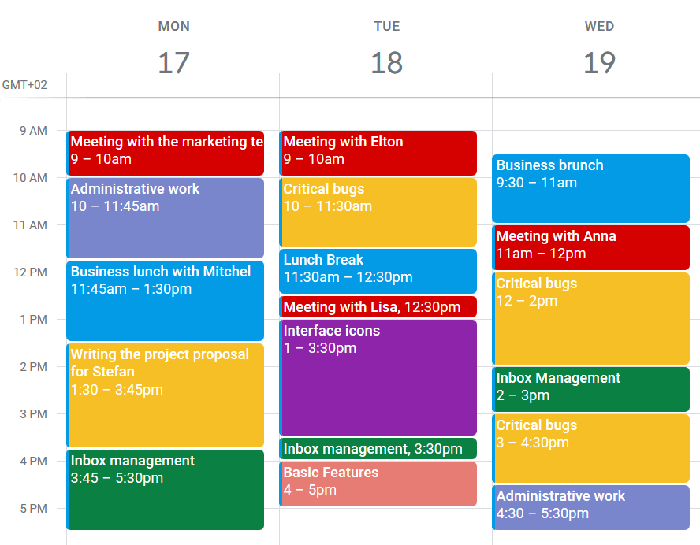
For illustration, if I were to time block my schedule, I’d set aside 4 hours in the morning for writing, 2 hours for editing, and 1 hour for responding to emails.
It doesn’t matter whether I finished an entire blog post within that 4 hours — as soon as my time block comes to an end, I move on to the next task. The whole point of time blocking is to give my day a structure, instead of nudging me into checking off my to-do list.
When you pick a time slot, you also get to decide how long each task is going to take. You can spend 15 minutes responding to emails and then do your focused work for 3 hours. There are no rules.
Time block your schedule with Clockify
Elon Musk, for example, chose to work in 5-minute time blocks while he was the acting chairman of Tesla and SpaceX. His decision to block his time helped him successfully run two colossal companies, while exercising twice a week and spending about 4 days of quality time per week with his children.
Why do you even need time blocking?
The reason is pretty obvious — we all need time blocking to take control of our time and strike a better work-life balance.
But how can assigning random colors to our tasks help us finish everything and still leave enough time to relax?
Well, it’s actually quite simple.
According to social psychology, every single one of us is having trouble making realistic plans. This phenomenon that bothers us all is called the planning fallacy and it makes us underestimate the time we need to complete our activities.
So, instead of giving myself 2 days to finish a 1000-word blog post (because that’s how long it usually takes), I claim I’ll finish it in one day.
Due to my misjudgment, I fail to meet my deadline and end up having to reschedule a bunch of other tasks to finish my article.
This is where the time blocking habit comes into play.
If I decide to set aside 6 hours to do the research, 2 hours to write my first draft, and 6 more hours to do the actual writing, I’m already better off than writing without a plan.
When we block specific chunks of time for each task we have at hand, planning becomes more realistic. Even if you fail to predict how much time you’ll need to finish something, the next time you need to do a similar task, you can always go back to your calendar, count the time blocks from before and make a completely accurate estimate.
Are there any other time blocking benefits?
Apart from rescuing you from the grips of the planning fallacy, time blocking has many more advantages — advantages you’ll notice as soon as you start scheduling your day with a little help from this technique.
But, until that happens, we’ll give you a preview of everything you can expect when you start blocking your tasks.
Time blocking will force you to focus on priorities
As soon as you start making the initial plan, you’ll feel the urge to block the hours when you feel the most focused on your most important tasks.
Perhaps you’ll see that you’re more focused in the mornings, so you’ll decide to block your early morning slots for tasks that are both important and urgent.
💡 Clockify Pro Tip
Maybe you enjoy waking up at the crack of dawn and starting work early. Or, maybe you prefer the peace and quiet the nighttime brings when you really feel like you can focus on your tasks. We present you with two blog posts that can help you maximize your productivity regardless of the time you feel the most productive:
Time blocking will reduce procrastination and distractions
When you have a task scheduled in your calendar, complete with prescribed start and end times, you’ll feel the urge to live up to that prescribed time, or even beat it — so, you’ll be more likely to overcome the urge to procrastinate or fall victim to distractions.
Time blocking will make you realistic about your time and work
Saying you’ll finish a project draft today is an optimistic guess at best unless you have this task written down in your schedule, with the expected time it will take you to finish — and time blocks give you just that.
Time blocking will help you keep a record of how you spend time
With time blocking, you’re essentially dividing your day into predefined time slots — for example:
- 1 hour for administration work,
- 1 hour for answering daily emails, and
- 3 hours for when you need to craft a project proposal.
As much as the time you block in your calendar serves as your guide for surviving your packed to-do list, it also serves as a reminder of what you’ve accomplished so far, and how much time you’ve spent on certain tasks. This data allows you to rethink your schedule, and whether attending meetings for 4 hours each day prevents you from focusing on other more important matters.
Time blocking will help you find time for everything
If you’re worried you haven’t been spending enough time with your kids lately, schedule a dedicated time block each day just for them.
If you have an important family dinner sometime soon, block your evening that day for it, and don’t let any excuse stop you from attending.
If you want to work on a creative hobby, schedule an hour each week for it, and stick to this time.
This is one of the biggest perks of this time management technique — you’ll not only reserve and save enough time for your work activities, but you’ll also save time for relaxation, hobbies, family, friends, or anything you want.
What about time blocking variations?
Time blocking is a life-changing time management technique on its own.
But, is it universal enough so that it can work for everyone? What if you simply need to attend dozens of meetings on Wednesdays and you can fit in most of your focused work on Mondays only?
This is where time blocking variations — task batching, time boxing, and day theming — come to the rescue.
Task batching
Unlike time blocking, task batching involves grouping similar tasks together and completing them in one sitting.
But how does that work exactly?
Let’s say you’re in charge of your company’s email marketing campaign. Instead of having to switch from designing an email strategy for an hour to writing a social media caption for 15 minutes, only to go back to your email campaign again, you can finish all your email-related tasks at once. Then, after you’re done, you simply move on to the next batch.

Time boxing
Although they look and sound similar, time boxing and time blocking are not the same — their main difference are their goals. Namely, while time blocking is meant to ensure you reserve time for your priority tasks, time boxing is all about limiting the time you’ll spend on tasks.
So, time boxing also requires you set aside a particular amount of time for a single task, but it prevents you from stretching the finish point to infinity by requiring you to set a clear goal you’ll complete within a specific time frame. Then, after you complete one time box, you stop working on your task and reflect on how successful you were in reaching your goal.
Track your goals with Clockify
The point of time boxing is to help you achieve a clearly defined goal and check it off your to-do list once you’re done with a time box.
So, instead of allocating 3 hours to a vague act of writing, I’ll promise myself to compose a 500–word draft version between 8 a.m. and 11 a.m. Once I’m done, I’ll cross it off since I completed my goal within that time frame.
This way, since I made my goal more specific and time-limited, I prevented myself from procrastinating and actually learned how to set better deadlines.
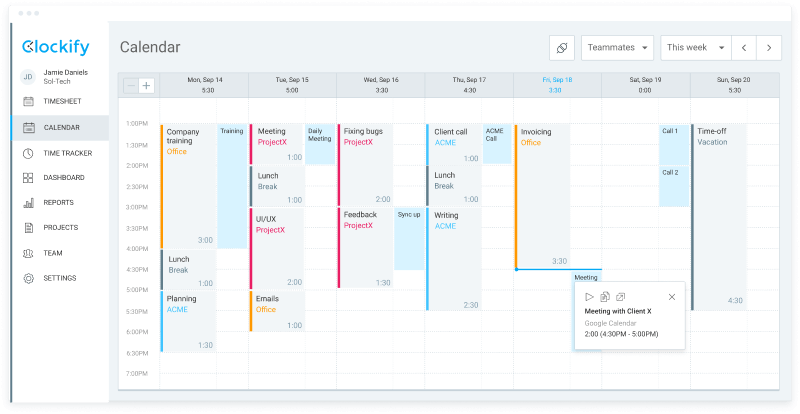
💡 Clockify Pro Tip
When there’s a busy day ahead, every minute counts. Find more details on how to make the most out of your schedule by timeboxing your day:
Day theming
Imagine having an entire day ahead of you just for creating content. No meetings, no emails, just a long uninterrupted stretch of creativity.
Well, this is what day theming is all about. You organize your day around one particular topic and give your undivided attention to it.
Then, the next day you get to attend meetings, clear up your inbox and give in to interruptions.
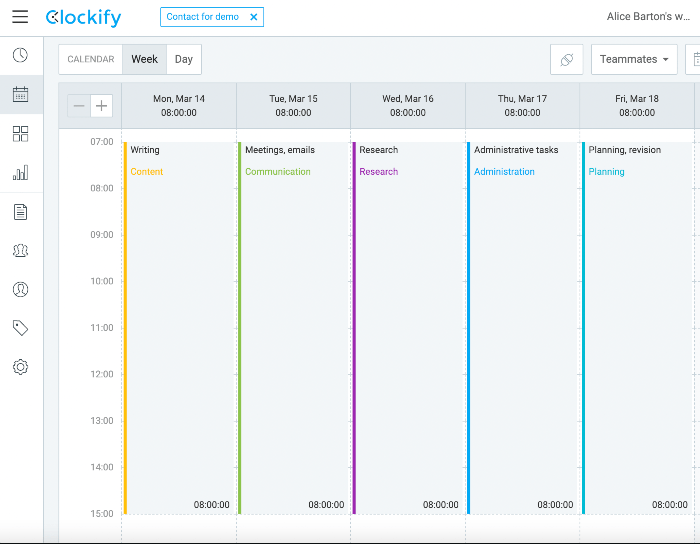
The CEO of Twitter, Jack Dorsey, follows this practice, so he spends entire Tuesdays on product-related activities, and entire Wednesdays on marketing activities.
Still, although day theming promises the biggest amount of focused hours, it does involve shutting off from every task that doesn’t fit into your day theme.
In case your job requires you to be present and available at all times, it might be better to go for a different time blocking variation.
How to time block your schedule
Now that we’ve uncovered all the fundamentals of time blocking, it’s time to see how to put this time management technique into action.
All you need to do is follow the 4 main time blocking steps:
- Plan everything
- Define time blocks
- Act on your schedule
- Test and revise
Plan everything
This first step sets everything in motion. This time you’ll need to brainstorm all tasks you may have to work on this week, and then work your way down from there.
Once you’re done brainstorming, you’ll likely find that you’ve listed a number of tasks that aren’t a priority or have a distant deadline. You can scrap these tasks for now, and aim to limit your daily schedules to 3–5 priority tasks per day.
These priorities can be recurring tasks you tackle every day, like answering important emails or handling client calls. Or, they can be tasks you tackle every so often, like handling some urgent administration work, or conducting research for your new project.
Either way, make sure you highlight these priority and unavoidable tasks in your to-do list. You can even add time estimates for each task, to make the next step easier.
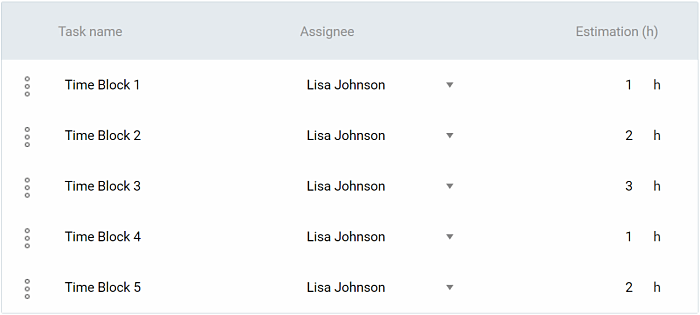
To simplify this process further, you can even split your tasks into smaller ones.
For example, instead of blocking an entire hour just to respond to emails, you can count the number of emails you’ve received that day and allocate 5 minutes to each email.
This way, you’ll avoid wasting 10 minutes on one email and then rushing to finish the next one in 2 minutes just to keep up with the time block.
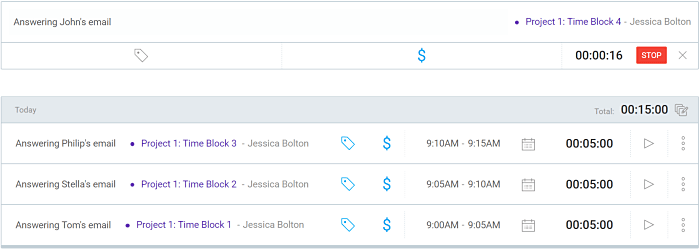
Once you’ve selected your priorities and compiled a detailed to-do list, it’s time that you define precise time blocks and mark them in your calendar.
Define time blocks
The second step requires you to focus on time only. Here you’ll need to decide:
- When to block time, by defining specific start and end times
- For how long to block time, by defining the task duration
When trying to come up with a response to these questions, don’t forget that it’s completely natural not to know how long some of your tasks might take. The more you practice time blocking, the more confident you’ll become at scheduling your tasks.
When do you need to block time?
According to the science of circadian rhythms, there’s an ideal time for all your activities. Whether you were about to relax or create your to-do list, you must have noticed that there are certain moments within your day when you accomplish your tasks more efficiently.
This would be your starting point.
Think about the time of the day when you’re the most alert, concentrated, and most likely to focus without distractions. This is the time when you should schedule your priority tasks.
Everything else, whether it’s business or personal, you should try to schedule around this “prime” time.
💡 Clockify Pro Tip
Still unsure what your optimal time for productivity is? Check out our guide to the Best Time Management Techniques to learn how to analyze your biological prime time and pinpoint your personal optimal time for priority work.
Alternatively, you can schedule your most important, urgent, or, simply, the most difficult task first thing in the morning — this practice is known as “eating your frog”, and it allows you to clear the rest of your daily schedule for more pleasant tasks as soon as possible.
For how long do you need to block time?
The science of Ultradian rhythms claims that our minds work in 90-minute cycles. But, if you are a fan of the popular Pomodoro principle, perhaps you’ve been working in 25-minute cycles.
So, for how long should you actually work?
First, you should limit your time block to 90 minutes. Science shows that you cannot concentrate on one activity without a break for more than an hour and a half. At least not if you want to produce quality work.
Both the science of Ultradian rhythms and the Pomodoro technique insist that you take frequent breaks — at least for 5 minutes after each work session. But, if you find the 90 minutes intervals too long, you can choose 25 minutes for your time blocks instead. This interval is long enough for you to focus, but short enough so that you don’t get too tired.
💡 Clockify Pro Tip
For the ultimate Pomodoro experience, try the Clockify extensions for Chrome, Firefox, and Edge. By getting a built-in Pomodoro timer you’ll be able to entirely focus on your work and let your timer remind you when to take a break.
Alternatively, you can mix them. Depending on the task you’re working on, you can block 90 minutes for more demanding work and 25 minutes for responding to emails, finishing the paperwork, etc.

Don’t forget that these are just some science-based suggestions. You can always try and test your own custom time blocks until you find that one strategy that works for you.
Act on your schedule
Once you’ve selected the what, and defined the when and for how long, you’ll need to “act” on your promises and follow your schedule.
Start with your first time block. Begin working on it at the prescribed start time, and stop working on it at the prescribed end time. Then, repeat, until you reach the end of the schedule for today.
This may seem like the easiest step in the time blocking process — you’ve laid out the ground rules, now you just need to follow them.
But, acting on your schedule will only become easy and simple once you figure out whether your prescribed time blocks work in real life — and this is where the revision step kicks in.
Test and revise
Once you start working on your time blocks, you might notice that your predictions are not always as accurate as you have expected them to be.
Perhaps you’ll find that effective meetings typically take 15 minutes and that you waste the other 10 minutes in an effort to live up to your prescribed time block.
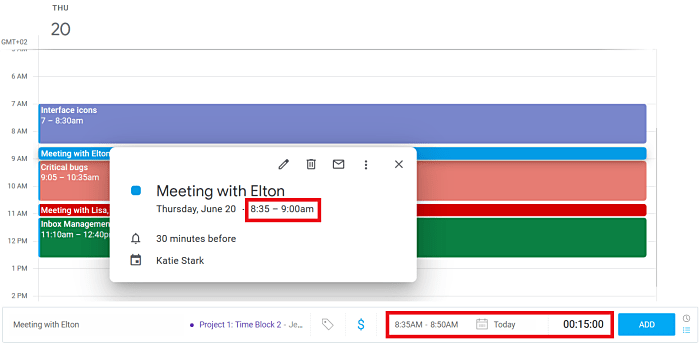
Although this is far from unexpected, in order to perfect your time blocking skills, you’ll need to pay close attention to how long each task takes to complete.
For this purpose, you can either try to watch the time as frequently as possible, or use a time tracker that can do this in the background for you.
If you’re using Clockify for this purpose, you can manually insert the name of the task you’re currently working on and start the timer in the desktop version as soon as you begin working.

Alternatively, you can use Clockify browser extensions and start the timer right from your browser.
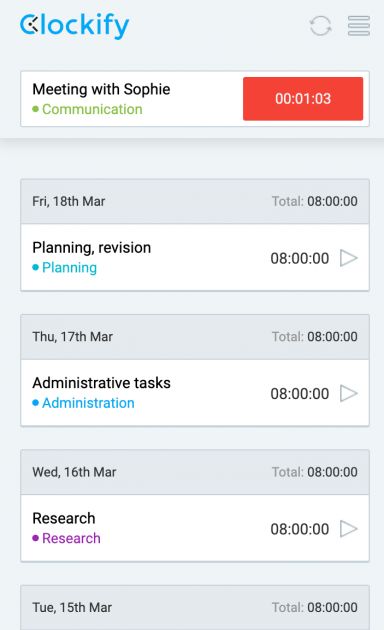
To save even more minutes, you can start the timer from anywhere in your browser, by selecting your desired text and right-clicking on it. Then, you’ll just need to click on the Start timer with description…
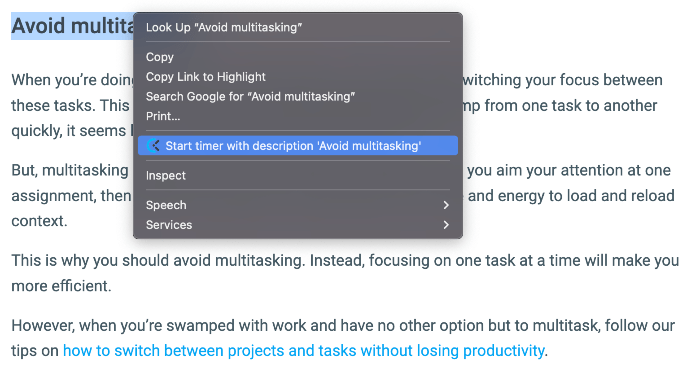
In case you’re about to join a meeting, you can even start the timer directly from the scheduled event.
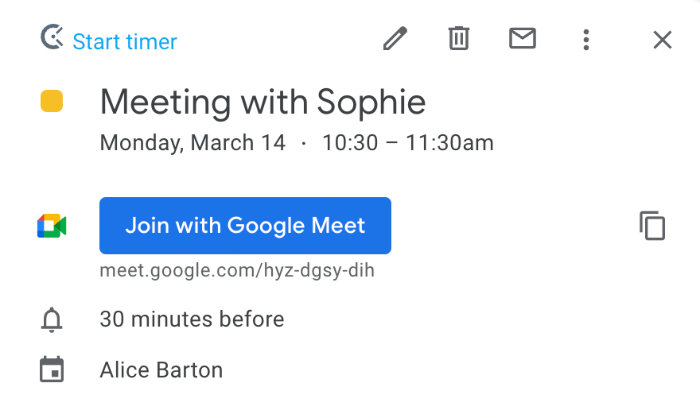
Once you’re done with the meeting, just click STOP to get the exact time you spent in it.
So, the next time you create a time blocking schedule, you will have your real-life time tracking results showing the time you spend on meetings to guide you towards a perfect time blocking routine.
How to avoid common time blocking mistakes
They say that If you don’t make mistakes, you don’t make anything, and this is especially true with time blocking. When you schedule a recurring task and see that you didn’t block enough time to complete it, this mistake will lead you to schedule smarter next time.
But, certain time blocking mistakes could cost you more time and energy in the long run, or even lead you to entirely give up on this time management technique without giving it a chance to transform your workflow.
So, instead of starting off as a novice and falling prey to beginners’ mistakes, consider the following tips and begin as a true time blocking expert.
Be ready to give up on things
Starting off with a new time management technique, especially the one that promises to revolutionize the way you do your work, is exciting for sure.
But, what if the excitement leads you to hold onto your schedule too tight, even when it becomes obvious that there are not enough hours in a day for you to complete everything? If this happens, not only will you probably give up on time blocking before the end of the week, but you’ll also increase your chances of burnout.
So, instead of holding onto your plans even when something unexpected occurs, be ready to move things around or give up on them altogether. Unless they need to be completed that very day, you can always make changes and postpone some of your tasks for tomorrow.
Alternatively, you can always think of the unexpected events in advance and schedule an additional hour just in case something doesn’t work as planned.
Don’t forget to schedule your breaks
It’s easy to get carried away with work, especially when things are going great and your time blocks seem to work out for you.
But, sooner or later, if you forget to schedule a break, you’ll end up overworked.
When this happens, you’re more likely to make mistakes and drive yourself to burnout.
Apart from risking your own wellbeing by working without breaks, you’re also likely to see your time blocking decision crumble in just a couple of days.
Make sure to set aside at least 5 minutes between each block and don’t forget to stick to the habit of putting everything on hold during this time interval.
You’re free to design your own break time to your preference, but make sure it doesn’t involve looking at screens.
Schedule an ‘in case something goes wrong’ day
Think of a day when everything runs smoothly — you manage to check off every single thing from your list and still have the energy to work out, go out, and read before going to bed.
How many such days per week do we get? Sometimes none, and that’s only human.
How do you recover from dozens of interruptions and unfinished tasks is what makes all the difference between a successful workweek and a week gone wrong.
So, however skillful you are at time blocking, always make sure to set aside at least a couple of hours just in case something unexpected comes up and you don’t even get to begin with your priority tasks.
This way, you can either reschedule the unexpected thing and tackle it during your ‘just in case’ hours, or deal with it immediately knowing that you still have enough time to go back to your top priorities.
If possible, try to schedule an entire day for all the tasks you’re falling behind with.
As soon as you see one whole day blocked just to catch up with things that make you feel overwhelmed throughout the week, you’ll instantly feel less stressed and more ready to follow through with your schedule.
Additional tips to make time blocking work for you
Although practice makes everything perfect, and you’ll probably master the habit of time blocking after a while, we’ve prepared some additional tips so that you can skip a few steps and make time blocking work for you right from the start.
Create time blocking templates
Blocking time in your calendar may take time, but you’ll speed things up if you create time blocking templates. You can create empty time slots with start and end times, and just fill them out with tasks.
Reserve empty time slots for your everyday activities — for example, reserve the times when you’ll exercise, take a morning shower, eat breakfast.
You can also reserve empty time slots for your priority tasks — if you’ve calculated your biological prime time, you’ll understand when your most effective time window is, and you’ll know to always reserve these pre-made time slots for your priority tasks.

💡 Clockify Pro Tip
Want to use ready-made time blocking templates for your tasks instead? We’ve got you covered with our 9 free time blocking templates you can download in PDF and then print out, or fill out in Google Sheets.
Let everyone know about your new habit
Most of the time, however carefully we plot our schedule, things get in the way. Sometimes we sabotage ourselves by procrastinating or giving in to non-urgent tasks, and other times other people simply come and interrupt and we end up multitasking throughout the day.
Although most of these interruptions are probably entirely justified, at least a significant amount of them could be avoided if people knew that you were too busy.
So, instead of hoping that nobody would schedule a meeting in the middle of your ‘’deep focus’’ block, inform your team members about the changes you’ve introduced to your workflow.
Mark your available hours in the calendar app and let everyone know of the best ways to get in touch with you quickly if there’s an emergency that cannot wait for your focused hours to finish.
Usually, as soon as your colleagues see you’re not available, most of them will make changes to their own plans and wait for your next opening to get in touch with you.
Don’t leave out your personal time
Although it might seem logical that you won’t forget to stop working at one point, sometimes it’s necessary to fit personal time into your calendar too.
But, blocking an ‘outside of office’ chunk of time does not mean that you have to plan your free time in advance if that feels too restrictive to you. Still, when there’s a busy day ahead of you and it seems like there’s no end to it, seeing a friendly face in the shape of a fun activity right at the bottom of your schedule always makes the day a bit brighter.
Schedule an ‘end of day’ ritual
‘End of day’ ritual does not go well only with time blocking. If you have ever practiced ‘’deep work’’ or read Cal Newport’s book on succeeding in a distracted world, you know how important it is to give your mind a signal that it’s time to call it a day.
Your ritual does not have to take hours, nor does it have to follow a particular structure.
You can schedule 5 to 15 minutes per day to review your time blocks, go over everything you’ve accomplished throughout the day and revise the blocks you’ve planned for tomorrow.
On Fridays, you can even turn it into an ‘End of the week’ review and go over the exact details of each of your time blocks.
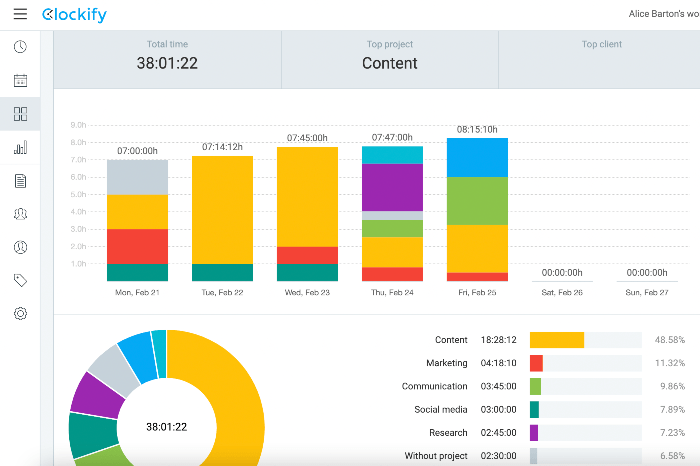
Not only will this routine help you quit thinking about work after you log out, but it will also make your future time blocks smarter — because it gives you a moment to reflect on your initial time blocking schedule.
Perhaps you’ll notice that you’ve initially planned to spend only two hours in meetings, but they ended up taking almost four hours of your time last week. So, now you know to set aside longer time blocks for communication in future.
Time blocking apps
We did mention that time blocking is a simple time management technique.
So you might be wondering, “If it’s that simple, why would you need a bunch of apps? Won’t they just overcomplicate things?”
As a matter of fact, they’ll do the exact opposite of that. The following time blocking apps will simplify your time blocking routine and ensure you make the least amount of mistakes as you go.
You’ll just need a:
- Time tracker — to help you figure out how exactly you spend your time (in real-time).
- To-do app, task management app, organizer, or planner — to help you stay on top of your priorities.
- Calendar app — to help you visualize your time blocks and let everyone else know when you’re available.
To help you waste the least amount of time preparing, we’ve singled out some of the best performers from each category and they go as follows:
- Clockify — time tracker app
- Google Calendar — classic calendar app
- Any.do — versatile task manager and calendar assistant
- Todoist — to do list app
- Fantastical — Mac calendar app
- Remember the Milk — to-do list and task management app
- DigiCal — daily planner
- Microsoft To Do — to-do list app
- ClickUp — task management app
- Things 3 — task management app
- TimeBloc – mobile daily planner
- TickTick – daily planner app
Clockify — time tracker app
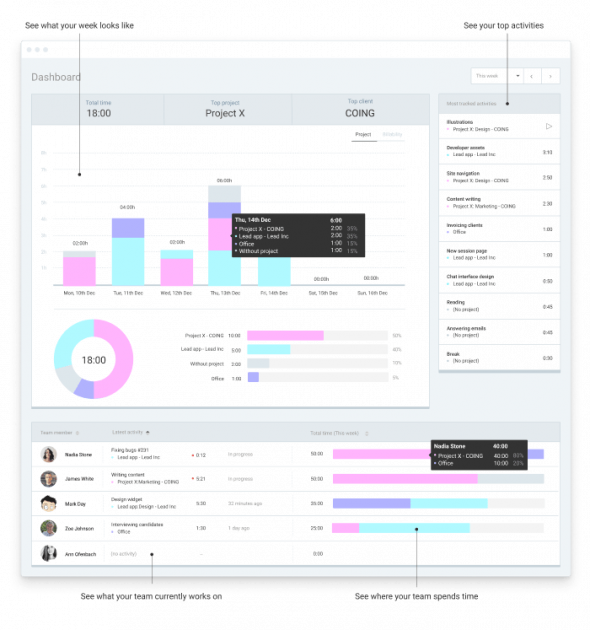
Clockify is a time tracker app with efficient time blocking features.
With Clockify, you’ll be able to track the time you spend on your scheduled time blocks as you work on them, and figure out whether you’ll need to make revisions for the same time blocks in the future.
You’ll also be able to:
- Track time in real-time, to the exact second it really takes you to finish a task
- Add the time you’ve already spent on scheduled time blocks manually on the Time Tracker page, or in a timesheet view
- Make estimates for your time blocks, and compare whether you really live up to these estimates
- Analyze the time you’ve spent on projects and tasks in Weekly, Detailed, and Summary Reports
- See both your tracked time and overlapping tasks in a Calendar view

- Use the integration with Google Calendar to track time on scheduled events and tasks without ever leaving Google Calendar
- Track time from almost every corner of the web since Clockify integrates with 80+ apps
You’ll also be able to define 4 different types of hourly rates, and have the time you track on scheduled time blocks automatically calculated into earnings in the Reports section of the app.
Clockify also offers a handful of additional features that come with different plans, so once you pick your preferred one, time blocking becomes a matter of minutes.
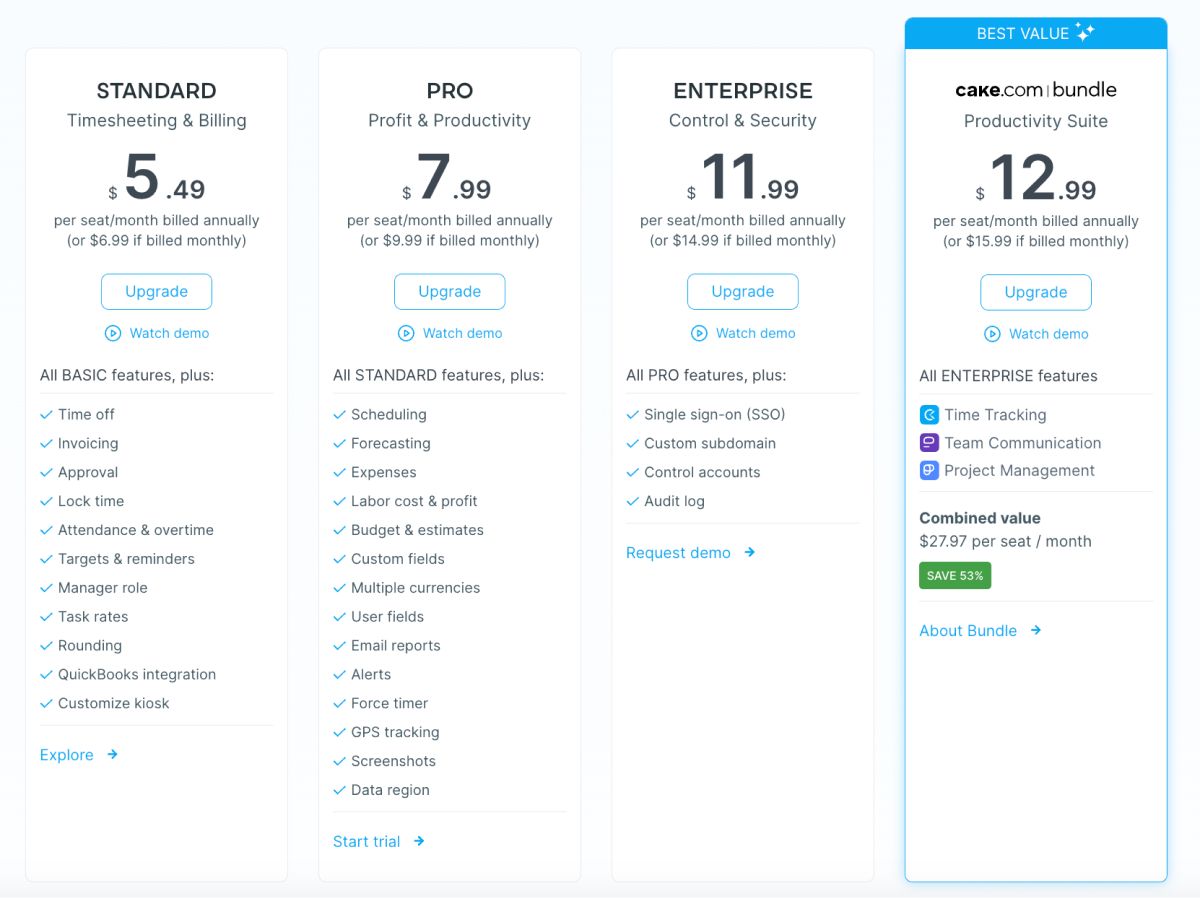
Available for: Web, Windows, Linux, Mac, iOS, Android, Chrome, Firefox, Edge
Google Calendar — classic calendar app
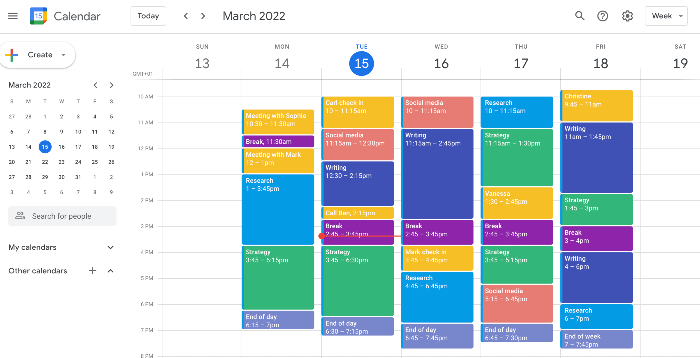
Google Calendar is a classic calendar app that allows you to schedule your events, tasks, and reminders in visual time blocks — each calendar entry represents a time block.
You’ll be able to:
- Create different, color-coded calendars for different parts of your life
- Plan periods of focused time and schedule reminders for repeating time blocks/tasks
- Schedule meetings with groups when everyone is available by analyzing suggested times
- Add events and schedule meetings with teammates from around the world
- Define your exact work hours, to have your teammates know when you’re available
- Enable Desktop notifications in order to be reminded of the next time block/task in your agenda
Google Calendar’s highlight feature helps remind you of your daily agenda — every morning before the start of your workday (around 5 a.m.), you’ll get an automatic email summarizing the events/reminders/tasks that await you that day.
Available for: Web, iOS, Android, Chrome, Firefox
Any.do — versatile task manager and calendar assistant
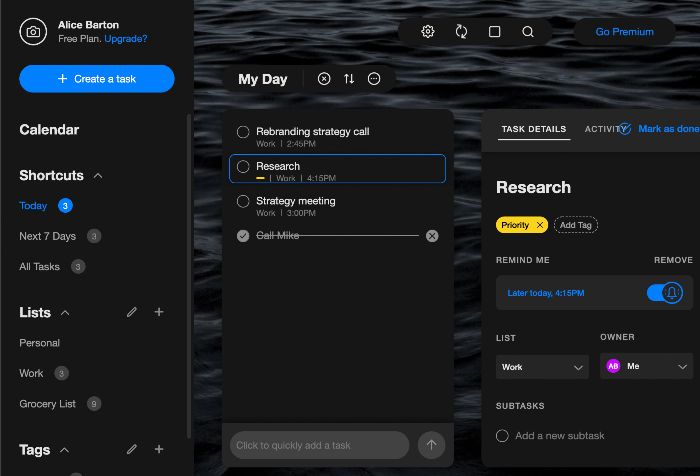
Any.do is an all-inclusive task manager with the features of a classic calendar, reminder, and planner app. You’ll be able to plan and implement your time blocking schedule, as well as collaborate with others in a joint time blocking system.
In essence, you’ll get to:
- Add tasks, prioritize the right ones, organize them as lists, and break them into sub-tasks
- Manage shared projects
- Define recurring tasks and set reminders for them
- Add events and tasks in your calendar, and then enjoy their combined view that highlights your busy hours and free time blocks
- Have all your lower priority tasks rescheduled automatically to leave more room for priorities
The highlight of this calendar app are its voice command features — you’ll get a chance to add events and tasks through dictation, ask for today’s agenda remotely, as well as tackle your to-do lists hands-free.
Available for: Web, Windows, Mac, iOS, Android, Chrome, Firefox, Apple Watch, Android Wear, Amazon Alexa, Siri, Google Assistant
Todoist — to-do list app

Todoist is the ultimate to-do list app, one that offers an array of task management features, as well as a number of integrations and syncing options.
In gist, you’ll be able to:
- Create tasks and assignments, and group them into projects
- Define deadline for tasks
- Orders tasks by priority level with color-coded flags
- Create and manage to-do lists
- Collaborate with others on projects and tasks
- Upload additional material to to-do items, and add enlightening comments to them
Todoist offers a more rounded task management experience than most similar apps, by letting you handle your projects as time blocks in a Calendar view and as Gantt charts — you’ll be able to view all your projects mapped up with their respective deadlines, project deliverables, and dependencies.
There’s also an option to see your productivity trends by weeks and months, set personalized goals, and receive points whenever you complete a task.
Available for: Web, iOS, Android, Windows, Mac, Linux, Chrome, Firefox, Edge, Safari, Apple Watch, Android Wear
💡Clockify Pro Tip
You can easily track time on Todoist to-dos with the Clockify-Todoist integration.
Fantastical – Mac calendar app
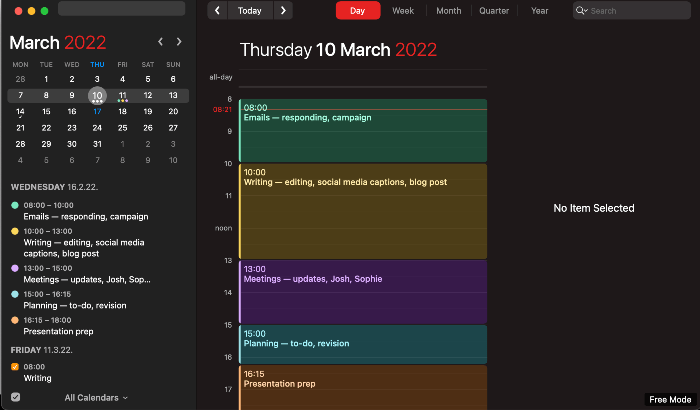
Fantastical is a Mac-exclusive calendar app with the usual time-blocking-friendly calendar features – you’ll be able to reorganize your schedule around team priorities, but also duplicate events across calendars and view your weekly agenda in a couple of clicks.
You’ll be able to:
- View maps showing the locations where you have scheduled events
- Make use of various calendar sets meant to help improve your scheduling
- Create reminders for your time blocked events and tasks in an instant by starting a sentence with “reminder” or “remind me to”
- Enjoy a full-calendar view for the time blocks you had scheduled per day, week, month, or year
- Add and join conference calls right from the app
The highlight feature of the app is its Mini Window — this Fantastical window inhabits your menu bar, and allows you to create, view, and edit events, tasks, and reminders in a faster way.
Available for: Mac
💡Clockify Pro Tip
If you’re a Mac user, you can use Clockify to track time in Pomodoro intervals, directly from the app.
Remember the Milk — to-do list and task management app
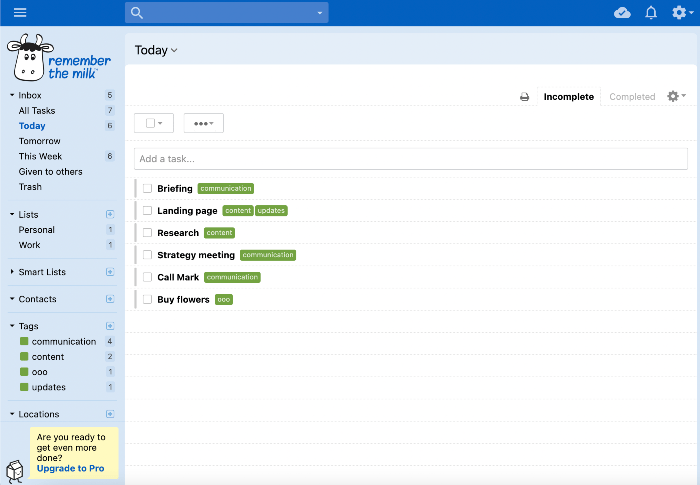
Remember the Milk is a to-do list and task management app meant to help you handle your to-do lists — especially if you have a busy schedule and are likely to forget about your priorities (like buying the milk).
You’ll be able to:
- Note down tasks and to-dos in a simple workspace
- Define reminders for each task and set them to arrive to you via Twitter, Text, or email
- Share lists and delegate tasks to others
- Organize and categorize your tasks with priority levels, tags, deadlines, and more
- Search for tasks, notes, and then save your most important searches as “Smart lists” for easier access
The standout feature of Remember the Milk is its recent Gmail add-on that lets you create new tasks right from your inbox, as well as its Zapier integration that gives you the option to connect Remember the Milk with hundreds of different apps.
Available for: Web, Windows, Mac, Linux, iOS, Android, BlackBerry, Apple Watch, Edge, Chrome, Firefox, Safari
DigiCal — daily planner
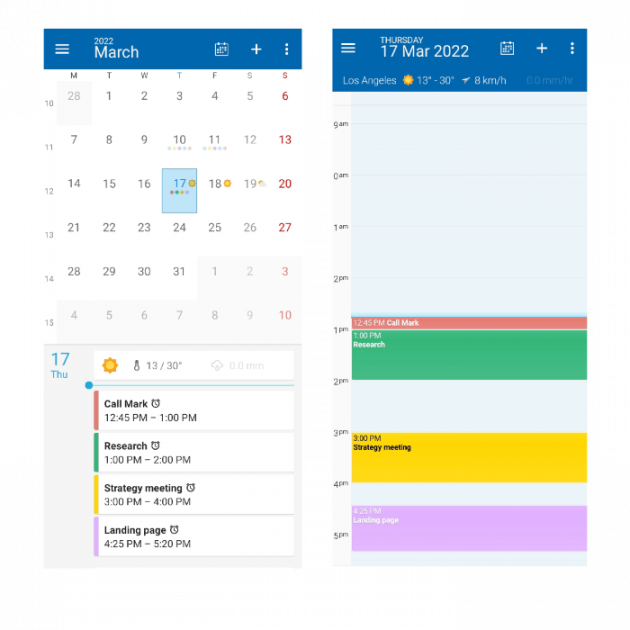
DigiCal is a straightforward daily planner in its core, but with multiple calendar views, widgets, a calendar catalog, and integrations with several notable online calendars.
Within this app, you’ll get to:
- Schedule appointments and then view them in 7 different calendar views, including a daily, weekly, monthly, or agenda overview of your events
- Enjoy 6 functional widgets and 9 preset themes
- Sync and plan your own schedule according to official TV schedules – tick your time blocked tasks, but also never miss an important game because of it
- Synch with the most popular online calendars, such as Google Calendar, Exchange, and Outlook.com
The standout feature of this app is its weather forecast, making it a perfect companion for outdoor photographers — you’ll be able to coordinate your outdoor events and tasks according to the outside temperature, clouds, wind conditions, as well as sunrise and sunset times.
Available for: Android
Microsoft To Do — to-do list app
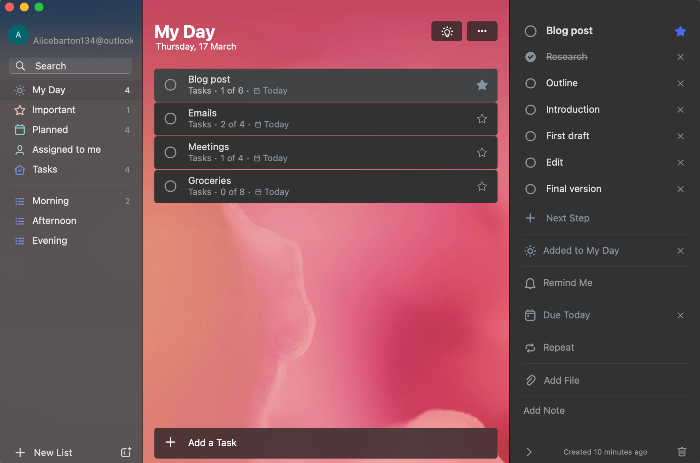
Microsoft To Do is a simple to use to-do list software that can help you prioritize, organize your tasks around a particular topic and share them easily so that everyone can see what you’re currently working on.
The app also gives you a chance to:
- Add sub-tasks to your larger projects
- Personalize your lists with different backgrounds and images
- Add tags to your tasks so that you can always find them
- Set due dates and reminders for each separate task
- Sync with Outlook.com and Microsoft Planner
Although much simpler than its robust competitors, Microsoft To Do’s standout feature is its collaborative function which allows you to assign tasks to other members as well as to add tasks assigned to you to your own to-do list.
Available for: Web, Windows, Mac, iOS, Android
ClickUp — task management app

ClickUp is an all-in-one project management platform designed to save you time and maximize your productivity.
You’ll be able to:
- Plan and organize your tasks
- Establish deadlines on a Calendar, Gantt, or Timeline
- Set time estimates and track time as you work
- Prioritize tasks with color-coded flags, Statuses, and tags
- Schedule recurring tasks and reminders
- Collaborate with your team and bring visibility to ongoing projects
- Access everything you need from one place
In addition to its built-in task management and time tracking features, ClickUp can integrate with 1000+ third-party apps, centralizing your work and taking some of the headache out of scheduling your days.
It also offers customizable time reporting Dashboards, so you can see which tasks or projects are taking up the most time, helping you when it’s time to readjust how you block your time.
Available for: Web, iOS, Android, Windows, Mac, Linux, Chrome, Firefox, Edge, Safari
Things 3 — task management app
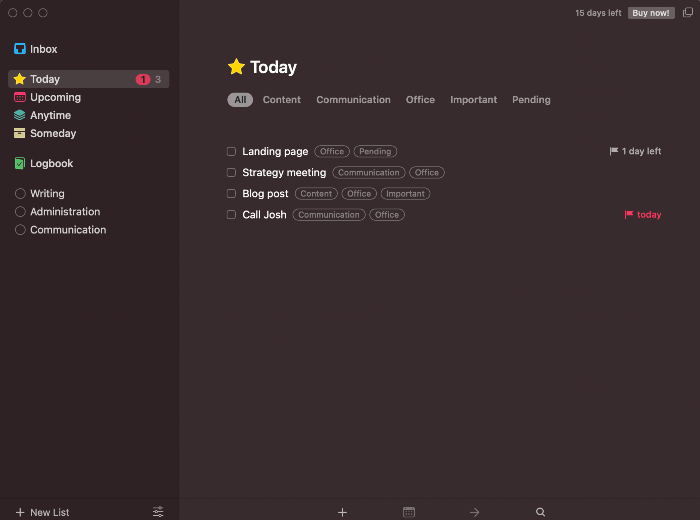
Things 3 is another task management app with a journal-like view — you’ll be able to make to-do lists, compile shopping and grocery lists, view tasks grouped by projects, and add notes to them. And all that according to the Getting Things Done methodology.
You’ll be able to block time for events in a simple Calendar view, and then group them by type – Work, Personal, Family, or any other custom classification you want.
You’ll also be able to:
- Collect to-do items that haven’t been categorized yet, and store them in the Inbox section of the app
- Create projects, add corresponding tasks you can checkmark to them, and then divide them into subheadings, for easier management
- Create areas, and group related projects together
The highlight element of this app are its scheduling features — you’ll be able to group tasks by the time of day they need to be tackled:
- Today — the section with all your priorities for that day
- In the evening — the section for all your priorities you don’t plan to tackle until the evening
- Upcoming — the section with postponed and automatically generated tasks
- Anytime — tasks you really haven’t blocked time for yet, but can tackle any time
- Someday — more tasks you really haven’t blocked time for yet, but need to be done at a certain time
Available for: Mac, iOS
TimeBloc – mobile daily planner
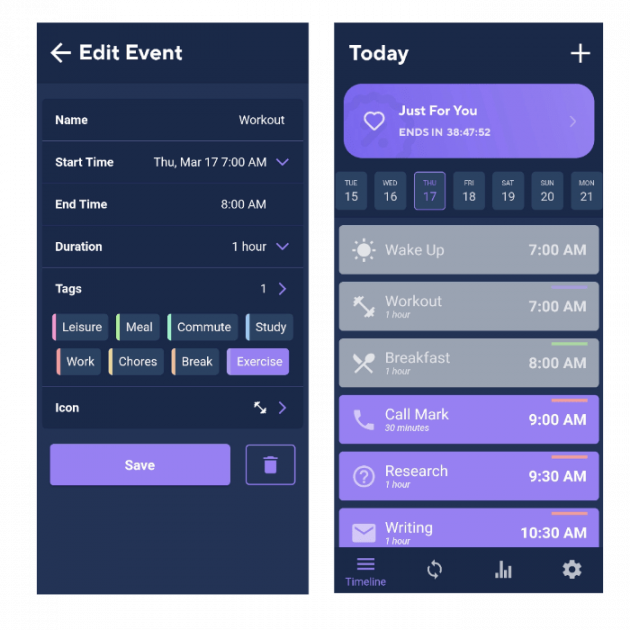
TimeBloc is a mobile-only app that allows you to divide your day into smaller tasks and events, tag and color code them so that you don’t miss out on anything important.
It also helps you to:
- Design your daily routine based on your recurring tasks
- Drag and drop your tasks quickly so that you can arrange them according to different time blocks
- See how exactly you spend your time by looking at your own time statistics
- Stay on track with your tasks by sending you reminders
- Have all your data in one place by syncing with your preferred mobile calendar
What makes this app stand out from its competitors are definitely the detailed reports that give its users insight into how they spend their days or even entire weeks.
By giving you the option to visualize everything you do throughout the day, TimeBloc helps you plan your days smarter and get into the habit of time blocking much quicker.
Available for: iOS, Android
TickTick – daily planner app

TickTick is a tool mainly designed for keeping up with tasks and deadlines. Since the app gives its users multiple choices for organizing and sorting their daily to-dos (such as folders, lists, tags, and priorities), it’s perfect for both time blocking and task batching.
TickTick also lets you to:
- Add tasks via voice command or by using Siri or Quick Ball
- Set up an estimated duration of each task
- Enable “Annoying alert” to ensure you won’t forget to complete tasks
- Quickly transform emails into tasks
- Share your lists with others
The highlight option that this app brings forward is the location reminder. TickTick gives you the option to set up a particular location for each of your tasks, so that as soon as the app registers that you are at a certain address it will automatically notify you of the task that needs to be completed there.
Available for: Web, Windows, Mac, Linux, iOS, Android, Chrome, Firefox, Apple watch
…In the end, is time blocking the time management technique for you?
In short — yes.
Although there’s no such thing as a miraculous time management technique that does the work instead of you, if you put a little effort into planning your days ahead, time blocking might get a step closer to doing wonders.
After all, we all get just 24 hours per day, so why not just block them? Even though this might not put everything on hold, at least we’ll understand where our precious time went and do it all again, a bit differently, tomorrow.
✉️ Have you ever tried time blocking? Did it help you transform your workflow? Maybe you have more tips and tricks for making the time blocking technique work right from the start. If you would like to share your thoughts, reach out to us at blogfeedback@clockify.me for a chance to be featured in this one or one of our future articles.



